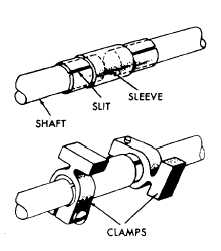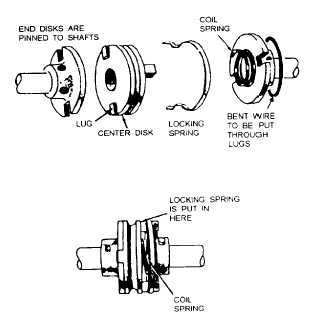Figure 11-15.-Sleeve coupling.
pivot, and the two links connect at two points in different
directions from the pivot. By properly locating the
connection points, the output links can move in any
desired direction.
All linkages require occasional adjustments or
repair, particularly when they become worn. To make
the proper adjustments, a person must be familiar with
the basic parts that constitute a linkage. Adjustments are
normally made by lengthening or shortening the rods
and shafts by a clevis or turnbuckle.
COUPLINGS
The term coupling applies to any device that holds
two parts together. Line shafts that make up several
shafts of different lengths may be held together by any
of several types of shaft couplings.
SLEEVE COUPLING
You may use the sleeve coupling (fig. 11-15) when
shafts are closely aligned. It consists of a metal tube slit
at each end. The slitted ends enable the clamps to fasten
the sleeve securely to the shaft ends. With the clamps
tightened, the shafts are held firmly together and turn as
one shaft. The sleeve coupling also serves as a
convenient device for making adjustments between
units. The weight at the opposite end of the clamp from
the screw merely offsets the weight of the screw and
clamp arms. Distributing the weight evenly reduces the
shaft vibration.
OLDHAM COUPLING
The Oldham coupling, named for its inventor,
transmits rotary motion between shafts that are parallel
but not always in perfect alignment.
Figure 11-16.-Oldham coupling.
An Oldham coupling (fig. 11-16) consists of a pair
of disks, one flat and the other hollow. These disks are
pinned to the ends of the shafts. A third (center) disk,
with a pair of lugs projecting from each face of the disk,
fits into the slots between the two end disks and enables
one shaft to drive the other shaft. A coil spring, housed
within the center of the hollow end disk, forces the
center disk against the flat disk. When the coupling is
assembled on the shaft ends, a flat lock spring is slipped
into the space around the coil spring. The ends of the flat
spring are formed so that when they are pushed into the
proper place, the ends of the spring push out and lock
around the lugs. A lock wire is passed between the holes
drilled through the projecting lugs to guard the
assembly. The coil spring compensates for any change
in shaft length. (Changes in temperature may cause the
shaft length to vary.)
The disks, or rings, connecting the shafts allow a
small amount of radial play. This play allows a small
amount of misalignment of the shafts as they rotate. You
can easily connect and disconnect the Oldham type
couplings to realign the shafts.
OTHER TYPES OF COUPLINGS
We use four other types of couplings extensively in
naval equipment:
1. The fixed (sliding lug) coupling, which is
nonadjustable; it does allow for a small amount of
misalignment in shafting (fig. 11-17).
2. The flexible coupling (fig. 11-18), which
connects two shafts by a metal disk. Two coupling hubs,
11-10




